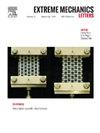均匀和梯度纳米高熵合金的散裂
IF 4.5
3区 工程技术
Q2 MATERIALS SCIENCE, MULTIDISCIPLINARY
引用次数: 0
摘要
在纳米晶结构中,通过调整晶粒尺寸可以提高材料的强度和硬度。然而,它们在极端冲击载荷下的行为在很大程度上仍未被探索。通过分子动力学模拟研究了均匀和梯度纳米CoCrFeMnNi高熵合金(H-HEA和G-HEA)的激波响应和散裂特性。结果表明:H-HEA和G-HEA均表现出弹塑性两波分离现象,且随晶粒尺寸的减小而减小;值得注意的是,随着晶粒尺寸的减小,H-HEA的破碎强度先减小后增大,而G-HEA始终表现出优于H-HEA的破碎强度。研究结果表明,GNG结构本身具有更好的抗冲击性能。晶粒强度与孔洞的成核能力密切相关,而孔洞的成核能力主要由无序结构的含量决定。在纳米晶结构中,孔洞主要在晶界处成核,随后的生长和聚并导致晶间断裂。此外,冲击载荷诱发各种塑性机制,如层错、变形孪晶和相变。这些发现强调了微结构设计,特别是GNG结构,在提高HEA的冲击力学性能方面的关键作用,并有助于HEA在极端冲击环境中的应用。本文章由计算机程序翻译,如有差异,请以英文原文为准。
Spallation in homogeneous and gradient nano-grained high-entropy alloys
The strength and hardness can be improved by adjusting grain size in nano-grained structures. However, their behavior under extreme shock loading remains largely unexplored. This study investigates the shock wave response and spallation characteristics of homogeneous and gradient nano-grained CoCrFeMnNi high-entropy alloys (H-HEA and G-HEA) by molecular dynamics simulation. The results demonstrate that both H-HEA and G-HEA exhibit an elastic-plastic two-wave separation phenomenon, which diminishes with decreasing grain size. Notably, the spall strength of H-HEAs initially decreases and then increases as the grain size decreases, while G-HEA consistently shows superior spall strength compared to H-HEA. The findings suggest that GNG structures inherently possess better shock resistance. The spall strength is closely related to the nucleation ability of voids, which is dominated by the content of disordered structure. In nano-grained structures, voids mainly nucleate at grain boundaries, and the subsequent growth and coalescence lead to intergranular fracture. Additionally, shock loading induces various plastic mechanisms such as stacking faults, deformation twinning, and phase transformations. These findings underscore the critical role of microstructural design, especially GNG structure, in enhancing the shock mechanical properties of HEAs and contribute to the application of HEA in extreme shock environments.
求助全文
通过发布文献求助,成功后即可免费获取论文全文。
去求助
来源期刊

Extreme Mechanics Letters
Engineering-Mechanics of Materials
CiteScore
9.20
自引率
4.30%
发文量
179
审稿时长
45 days
期刊介绍:
Extreme Mechanics Letters (EML) enables rapid communication of research that highlights the role of mechanics in multi-disciplinary areas across materials science, physics, chemistry, biology, medicine and engineering. Emphasis is on the impact, depth and originality of new concepts, methods and observations at the forefront of applied sciences.
 求助内容:
求助内容: 应助结果提醒方式:
应助结果提醒方式:


